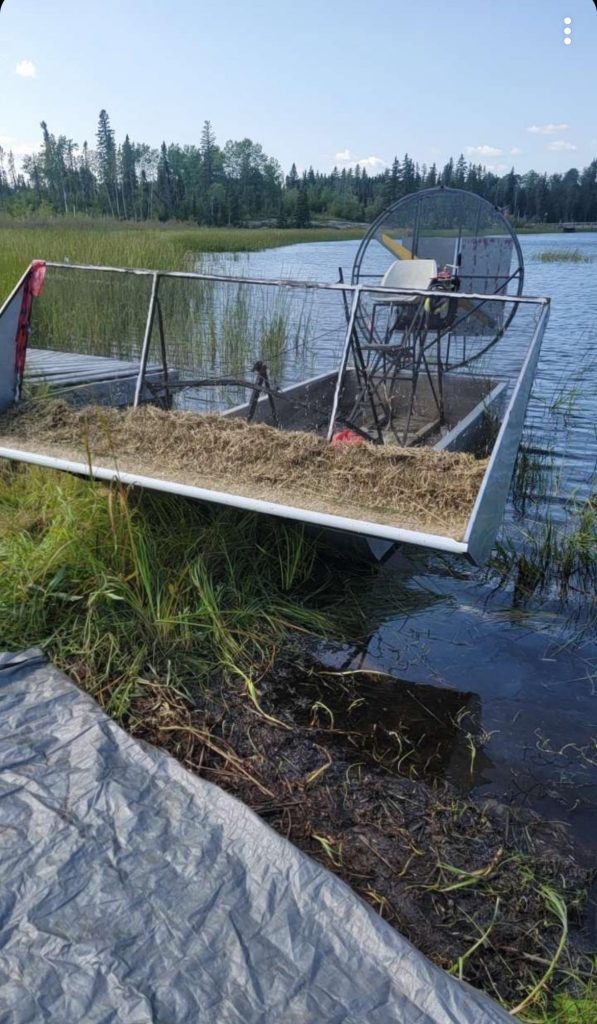
Northern colleges join forces with NWC Wild Rice to improve harvest techniques
Wild rice is considered sacred in the Métis communities of northwestern Saskatchewan.
Métis have participated in the wild rice industry, which has been taken over by commercial interests.
“Wild rice is a sacred space granted to Indigenous people millennia before any European interest entered into the conversation, or the commercialism of wild rice,” Nap Gardiner, chief executive officer for NWC Wild Rice, said, in an interview with the Northern Advocate.
Métis in northern Saskatchewan have continued to be a part of the wild rice industry, but they have also worked to become a more equal partner in the industry.
One such endeavour is establishing their own organization, NWC Wild Rice, whose members are Indigenous.
“This is part of the evolution of what it is we intended to do,” Gardiner said.
One of the major challenges to wild rice harvesters, the equipment is becoming obsolete, parts for existing equipment are hard, if not impossible to find.
“We have a rag tag fleet of air boats across the region and we keep hoping that someday somebody will put a new design in …. We approached the institutions that have some responsibility, such as Saskatchewan Polytechnic GDI to figure out, not only how we sustain the existing equipment till such time as we can design new boats, because we need to invest and seek out money to do that,” Gardiner said.
Saskatchewan Polytechnic received $400,000 in funding through Prairie’sCan Community Economic Development and Diversification (CEDD) to work with NWC Wild Rice to improve their production options.

Chris Thompson heads up the Ag Equipment Technician Program with Saskatchewan Polytechnic.
“The project started as a way for an applied research project to help the wild rice harvesters become more productive,” Thompson said in an interview with the Northern Advocate. “On inspections of the boats and more work with the community, we really came to the conclusion that the boats needed to be redesigned in regard to the engines are too unreliable, parts are becoming very difficult to get, and the producers were having a hard time maintaining their boats in operating cause the parts buy was so bad.”
Working with NWC, they were able to get the funding and begin working on finding solutions to the wild rice harvesters dilemma.
Thompson said the program he heads is responsible for management and training technicians. He comes with 30-years’ experience as a technician and the project is underway.
“We looked at how we are going to make these boats a little more safe,” he explained.
They have been exploring the use of parts used in the ultra-light aircraft industry, but, have found they are very expensive and non-repairable.
“My concept is we’re looking at different four-stroke engine gasoline and potentially diesel and a different kind of drive system,” Thompson said. The goal is to create something that just relies on commonly used parts that would be easily accessible.
They have developed a boat that is “just our demonstration boat. We’re in the process of building a hull engine and drive system is. Well designed and we should be able to have this thing as a demonstration boat in the fall,” Thompson said.
They also have partnered with the Gabriel Dumont Institute (GDI) and Northlands College “to deliver a training package for people that support the wild rice harvester and give them some basics.”
The training, which is a “whole other project” would help harvesters with some “added technical information about why engines fail, a little bit about electrical, about engines, about some safety.”
“We have a set of courses designed that will cover boat safety, boat design and sort of have it be one neat package that producers or the people that support producers can take,” Thompson said.
The courses will be through GDI, supported by Northlands College and Saskatchewan Polytechnic, he explained.
“We are kind of laying the foundation down for the future. Once we come up with the finished design of a new harvester boat there will be people in the community very familiar with the portions of that boat that they might not have been used to seeing in a boat,” he said.
Thompson said he’s “very passionate about agriculture, helping anybody … “ and, although wild rice is actually aquaculture, for the purpose of this project, it comes under agriculture.
As the project continues, they have an applied research group working on it, an agricultural equipment program and applied research departments, “that brings us access to pretty much every program at Saskatchewan Polytechnic.”
The demonstration boat “is going to show that our engine and our propeller system will work in the shape of a boat that the producers are very used to.”
Once the design boat is completed, “we’re going to build these boats for wild rice harvester communities everywhere across Saskatchewan,” Thompson said.
In a phone interview on Sept. 8, Thompson said they have a boat made to test and a new engine system. They’ll also have the dual operator system ready, and hope to test it on the water by mid-October.
He also added that things are moving alone with their research.
“We just got back from Beauval like last night late. We were up spending some days with harvesters, listening to their what their interests are, what do they want to see fixed, what are their biggest concerns. We took part in the harvest around the Beauval area.”
Gardiner said he’s encouraged by the new developments.
“It’s putting back Indigenous people to where it is that they have a right to make their homes. Like I said in my opening comments, Wild Rice was a gift from creation for Indigenous people.” he said.

